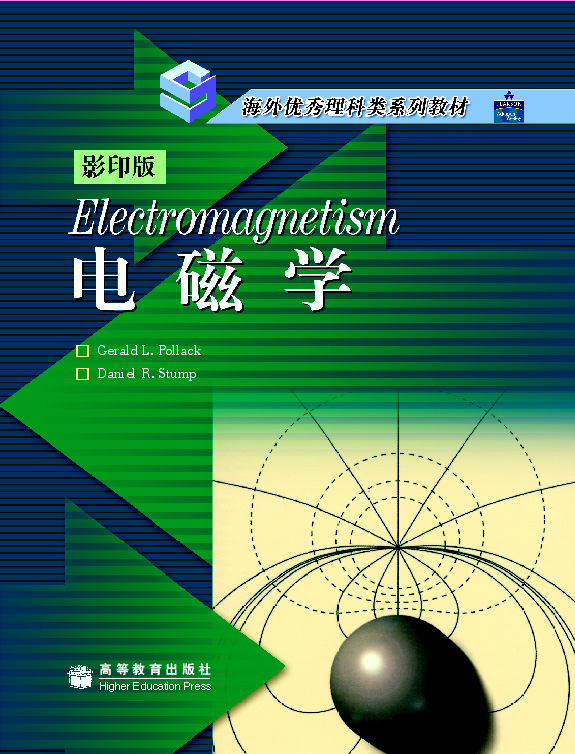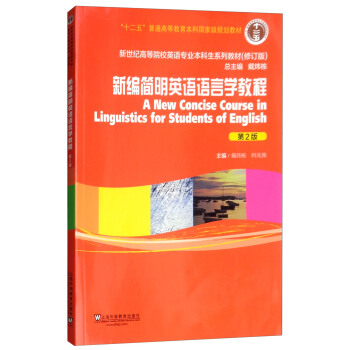- 高等教育出版社
- 9787040165760
- 1版
- 129744
- 48261826-1
- 平装
- 异16开
- 2005-05
- 400
- 620
- 理学
- 物理学类
- O441
- 物理类
- 本科 教育培训
《海外优秀理科类系列教材:电磁学(影印版)》是在美国大学使用比较广泛的一本为本科生编写的电磁学教材。虽然在总体上,该教材仍然是一本比较传统的教材,但作者仍然在如何能帮助学生更好的学习电磁学课程做了不少努力。例如,提供不少和实际联系比较紧密的例子,讲解详细的例题以及提供了不少使用计算机解 决问题的算例。这些内容对于学生理解电磁学内容,应用所学知识都有很好的帮助。另外,该教材的习题难度适中,并有不少提示,对于巩固学习内容也有很好的帮助。
《海外优秀理科类系列教材:电磁学(影印版)》的难度和国内教学要求比较接近,可作为物理类专业电磁学课程的教材,尤其适合开展双语教学的学校,对于有志出国深造的人员也是一本必不可少的参考书。
1 History and Perspective
1.1 Brief History of the Science of Electromagnetism
1.2 Electromagnetism in the Standard Model
2 Vector Calculus
2.1 Vector Algebra
2.1.1 Definitions
2.1.2 Addition and Multiplication of Vectors
2.1.3 Vector Product Identities
2.1.4 Geometric Meanings
2.2 Vector Differential Operators
2.2.1 Gradient of a Scalar Function
2.2.2 Divergence of a Vector Function
2.2.3 Curl of a Vector Function
2.2.4 DelIdentities
2.3 Integral Theorems
2.3.1 Gauss's Theorem
2.3.2 Stokes's Theorem
2.3.3 Vector Calculus in Fluid Mechanics
2.4 Curvilinear Coordinates
2.4.1 General Derivations
2.4.2 Cartesian, Cylindrical, and Spherical Coordinates
2.5 The Helmholtz Theorem
3 Basic Principles of Electrostatics
3.1 Coulomb's Law
3.1.1 The Superposition Principle
3.2 The Electric Field
3.2.1 Definition
3.2.2 Charge as the Source of E
3.2.3 Field of a Charge Continuum
3.3 Curl and Divergence of E
3.3.1 Field Theory Versus Action at a llistance
3.3.2 Boundary Conditions of the Electrostatic rreia
3.4 The Integral Form of Gauss's Law
3.4.1Flux and Charge
3.4.2 Proof of Gauss's Law
3.4.3 Calculations Based on Gauss's Law
3.5 Green's Function and the Dirac delta Function
3.5.1 The Dirac delta Function
3.5.2 Another Proof of Gauss's Law
3.6 The Electric Potential
3.6.1 Definition and Construction
3.6.2 Poisson's Equation
3.6.3 Example Calculations of V (x)
3.7 Energy of the Electric Field
3.8 The Multipole Expansion
3.8.1 Two Charges
3.8.2 The Electric Dipole
3.8.3 Moments of a General Charge Distribution
3.8.4 Equipotentials and Field Lines
3.8.5 Torque and Potential Energy for a Dipole in an Electric Field
3.9 Applications
3.10 Chapter Summary
4 Electrostatics and Conductors
4.1 Electrostatic properties of conductors
4.2 Electrostatic Problems with Rectangular Symmetry
4.2.1 Charged Plates
4.2.2 Problems with Rectangular Symmetry and External Point Charges. The Method of Images
4.3 Problems with Spherical Symmetry
4.3.1 Charged Spheres
4.3.2 Problems with Spherical Symmetry and External Charges
4.4 Problems with Cylindrical Symmetry
4.4.1 Charged Lines and Cylinders
4.4.2 Problems with Cylindrical Symmetry and an External Line Charge
5 General Methods for Laplace's Equation
5.1 Separation of Variables for Cartesian Coordinates
5.1.1 Separable Solutions for Cartesian Coordinates j.r.t nxamptes
5.2 Separation of Variables for Spherical Polar Coordinates
5.2.1 Separable Solutions for Spherical Coordinates
5.2.2 Legendre Polynomials
5.2.3 Examples with Spherical Boundaries
5.3 Separation of Variables for Cylindrical Coordinates
5.3.1 Separable Solutions for Cylindrical Coordinates
5.4 Conjugate Functions in 2 Dimensions
5.5 Iterative Relaxation: A Numerical Method
6 Electrostatics and Dielectrics
6.1 The Atom as an Electric Dipole
6.1.1 Induced Dipoles
6.1.2 Polar Molecules
6.2 Polarization and Bound Charge
6.3 The Displacement Field
6.3.1 Linear Dielectrics
6.3.2 The Clausius-Mossotti Formula
6.3.3 Poisson's Equation in a Uniform Linear Dielectric
6.4 Dielectric Material in a Capacitor
6.4.1 Design of Capacitors
6.4.2 Microscopic Theory
6.4.3 Energy in a Capacitor
6.4.4 A Concrete Model of a Dielectric
6.5 Boundary Value Problems with Dielectrics
6.5.1 The Boundary Conditions
6.5.2 A Dielectric Sphere in an Applied Field
6.5.3 A Point Charge above a Dielectric with a Planar Bound-ary Surface
6.5.4 A Capacitor Partially Filled with Dielectric
7 Electric Currents
7.1 Electric Current in a Wire
7.2 Current Density and the Continuity Equation
7.2.1 Local Conservation of Charge
7.2.2 Boundary Condition on J(x, r)
7.3 Current and Resistance
7.3.1 Ohm's Law
7.3.2 Fabrication of Resistors
7.3.3 The Surface Charge en a Current Carrying Wire
7.4 A Classical Model of Conductivity
7.5 Joule's Law
7.6 Decay of a Charge Density Fluctuation
7.7 1-V Characteristic of a Vacuum-Tube Diode
7.8 Chapter Summary
8 Magnetostatics
8.1 The Magnetic Force and the Magnetic Field
8.1.1 Force on a Moving Charge
8.1.2 Force on a Current-Carrying Wire
8.2 Applications of the Magnetic Force
8.2.1 Helical or Circular Motion of q in Uniform B
8.2.2 Cycloidal Motion of q in Crossed E and B
8.2.3 Electric Motors
8.3 Electric Current as a Source of Magnetic Field
8.3.1 The Biot-Savart Law
8.3.2 Forces on Parallel Wires
8.3.3 General Field Equations for B(x)
8.4 Ampere's Law
8.4.1 Ampere Law Calculations
8.4.2 Formal Proof of Ampere's Law
8.5 The Vector Potential 280
8.5.1 General Solution for A(x)
8.6 The Magnetic Dipole
8.6.1 Asymptotic Analysis
8.6.2 Dipole Moment of a Planar Loop
8.6.3 Torque and Potential Energy of a Magnetic Dipole
8.6.4 The Magnetic Field of the Earth
8.7 The Full Field of a Current Loop
9 Magnetic Fields and Matter
9.1 The Atom as a Magnetic Dipole
9.1.1 Diamagnetism
9.1.2 Paramagnetism
9.2 Magnetization and Bound Currents
9.2.1 Examples
9.2.2 A Geometric Derivation of the Bound Currents
9.3 Am砂re's Law for Free Currents. and H
9.3.1 The Integral Form of Ampere's Law
9.3.2 The Constitutive Equation
9.3.3 Magnetic Susceptibilities
9.3.4 Boundary Conditions for Magnetic Fields
9.4 Problems Involving Free Currents and Magnetic Materials
9.5 A Magnetic Body in an External Field: The Magnetic Scalar Potential Φm(x)
9.6 Ferromagnetism
9.6.1 Measuring Magnetization Curves: The Rowland Ring
9.6.2 Magnetization Curves of Ferromagnetic Materials
9.6.3 The Permeability of a Ferromagnetic Material
10 Electromagnetic Induction
10.1 Motional EMF
10.1.1 Electromotive Force
10.1.2 EMF from Motion in B
10.1.3 The Faraday Disk Generator
10.2 Faraday's Law of Electromagnetic Induction
10.2.1 Mathematical Statement
10.2.2 Lenz's Law
10.2.3 Eddy Currents
10.3 Applications of Faraday's Law
10.3.1 The Electric Generator and Induction Motor
10.3.2 The Betatron
10.3.3 Self-Inductance
10.3.4 Classical Model of Diamagnetism
10.4 Mutual Inductance
10.5 Magnetic Field Energy
10.5.1 Energy in a Ferromagnet
11 The Maxwell Equations
11.1 The Maxwell Equations in Vacuum and the Displacement Current
11.1.1 The Displacement Current
11.2 Scalar and Vector Potentials
11.2.1 Gauge Transformations and Gauge Invariance
11.2.2 Gauge Choices and Equations for A(x,t) and V(x,t)
11.3 The Maxwell Equations in Matter
11.3.1 Free and Bound Charge and Current
11.3.2 Boundary Conditions of Fields
11.4 Energy and Momentum of Electromagnetic Fields
11.4.1 Poynting's Theorem
11.4.2 Field Momentum
11.5 Electromagnetic Waves in Vacuum
11.5.1 Derivation of the Wave Equation
11.5.2 An Example of a Plane Wave Solution
11.5.3 Derivation of the General Plane Wave Solution
11.5.4 A Spherical Harmonic Wave
11.5.5 The Theory of Light
12 Electromagnetism and Relativity
12.1 Coordinate Transformations
12.1.1 The Galilean Transformation
12.1.2 The Lorentz Transformation
12.1.3 Examples Involving the Lorentz Transformation
12.2 Minkowski Space
12.2.1 4-vectors, Scalars, and Tensors
12.2.2 Kinematics of a Point Particle
12.2.3 Relativistic Dynamics
12.3 Electromagnetism in Covariant Form
12.3.1 The Lorentz Force and the Field Tensor
12.3.2 Maxwell's Equations in Covariant Form
12.3.3 The 4-vector Potential
12.4 Field Transformations
12.5 Fields Due to a Point Charge in Uniform Motion
12.6 Magnetism from Relativity
12.7 The Energy-Momentum Flux Tensor
13 Electromagnetism and Optics
13.1 Electromagnetic Waves in a Dielectric
13.2 Reflection and Refraction at a Dielectnc Interface
13.2.1 Wave Vectors
13.2.2 Reflectivity for Normal Incidence
13.2.3 Reflection for Incidence at Arbitrary Angles: Fresnel's Equations
13.3 Electromagnetic Waves in a Conductor
13.3.1 Reflectivity of a Good Conductor
13.4 A Classical Model of Dispersion: The Frequency Dependence of Material Properties
13.4.1 Dispersion in a Dielectric
13.4.2 Dispersion in a Plasma
14 Wave Guides and Transmission Lines
14.1 Electromagnetic Waves Between Parallel Conducting Planes
14.1.1 The TEM Solution
14.1.2 TE Waves
14.1.3 TM Waves
14.1.4 Summary
14.2 The Rectangular Wave Guide 540
14.2.1 Transverse Electric Modes TE(m, n)
14.2.2 Transverse Magnetic Modes TM(m, n)
14.3 Wave Guide of Arbitrary Shape 549
14.4 The TEM Mode of a Coaxial Cable
14.5 Cavity Resonance
15 Radiation of Electromagnetic Waves
15.1 The Retarded Potentials 561
15.1.1 Green's Functions
15.2 Radiation from an Electric Dipole
15.2.1 The Hertzian Dipole
15.2.2 Atomic Transitions
15.2.3 Magnetic Dipole Radiation
15.2.4 Complete Fields of a Hertzian Dipole
15.3 The Half-Wave Linear Antenna
15.4 The Larmor Formula: Radiation from a Point Charge
15.5 Classical Electron Theory of Light Scattering
15.6 Complete Fields of a Point Charge: The Li6nard-Wiechert Potentials
15.6.1 A Charge with Constant Velocity
15.6.2 The Complete Fields
15.6.3 Generalization of the Larmor Formula
A Electric and Magnetic Units
B The Helmholtz Theorem
Index








